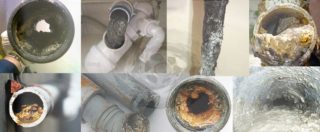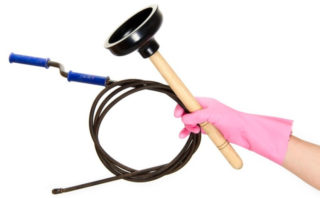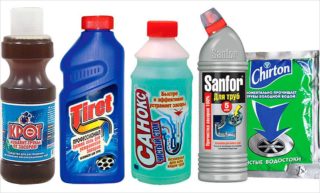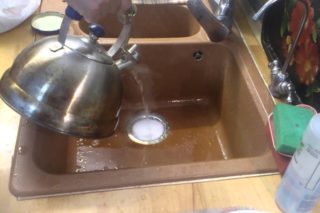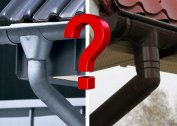Blockages in pipes lead to the fact that the sewage system "rises", it is impossible to drain the waste liquids, a disgusting smell appears in sanitary and kitchen rooms. It’s realistic to clean the sewer pipes in a private house with your own hands. Hiring professionals is required only in the most difficult cases.
The main causes of sewage blockages
If in a country cottage connected to an autonomous sewage treatment plant the water does not drain in the drains and there is a nasty smell, it may not be a clog. First you need to check the septic tank or cesspool - perhaps the capacity is full. In this situation, you need to call the scavengers, after pumping, the sewer system will resume.
Drain water in combination with a sewer stink with normally functioning VOCs is a clear sign of clogging of the pipeline. Possible reasons:
- Fat clusters. Their culprits are kitchen drains.
- Paper, especially newsprint, which was thrown into the toilet in a large volume, as well as any other large garbage.
- Hair and coat of animals. Usually they enter the sewer line from the drain of the bath, less often from the wash basin.
- Use of a kitchen sink without a retention net.
- Non-compliance with the inclination of the pipeline.
- Freezing of the external pipeline section.
Tree roots are also able to affect the efficiency of the sewage system. Plants planted close to the highway, over time, can penetrate the rhizomes into the pipeline and "clog" it.
An undersized trunk is quickly clogged and needs to be cleaned.
Most often, blockages occur in cast iron pipes. This happens due to the fact that the inner surface becomes rough due to corrosive influences, so garbage sticks to it more easily. The inside of the plastic pipes is smooth, they are not subject to corrosion, but it is not advisable to clean such material with excessively caustic preparations.
Definition of localization of blockages
 To eliminate the blockage, it is necessary to find where exactly the pipeline is clogged. Often there are blockages in the drains of kitchen sinks, bathtubs and toilets. The place of formation of the cork can be determined by poor drainage of the water stream.
To eliminate the blockage, it is necessary to find where exactly the pipeline is clogged. Often there are blockages in the drains of kitchen sinks, bathtubs and toilets. The place of formation of the cork can be determined by poor drainage of the water stream.
To localize the problem area, you need to check the following places:
- If the water goes poorly into the kitchen drain, a cork has occurred in the area from the sink to the bathroom.
- If the liquid stagnates in the washbasin and the bath, the mash is in the section from the sink to the toilet.
- If the drains do not leave the toilet only, the blockage is in the outlet pipe.
Cleaning is performed from an extreme sanitary device, where there is no water flow.
Methods for cleaning the sewer in a private house
Small problems can be dealt with using auxiliary tools. If the problem is a wrong slope of the pipe sections or a serious breakdown of the network, you will have to disassemble it and reinstall it.
Mechanical way
Small plugs are traditionally eliminated using a plunger. The plumbing tool is a smooth wooden handle with a rubber bowl on the end. Cleaning is carried out in the following order:
- If there is not enough water in the sink, you will need to draw it so that it covers the bowl.
- The plunger is pressed against the drain hole, translational movements are made up and down.
- The device rises sharply. If the water quickly went into the drain, then the blockage is removed. If not, you will have to repeat the procedure several times.
The pressure created by the bowl helps to ensure that the debris moves and continues to move along the pipe.
If nothing comes out with the plunger, or the mash “hid” in the depths of the highway, cleaning is carried out using a special cable. It is most often used if large debris has got into the sewer system, for example, a rag or diaper. The device is fed to the clogging place by constantly rotating the handle. The flexible cable must be in constant tension, otherwise it will be twisted by loops. When the nozzle hooks the debris and the liquid drains, the cable is slowly pulled out of the pipe. At the same time, they continue to rotate in the same direction as before: this ensures that the object does not break and does not cause a new blockage. Cleaning is carried out from top to bottom through the outlet to connect the washbasin, bathtub, kitchen sink or inspection hole.
The advantages of mechanical methods are low cost. You can buy a plunger for 80 rubles or a cable with nozzles for 150 rubles and clean the pipeline with your own hands.
You can also use a machine with a cable and an electric motor. With the help of powerful equipment, even dense blockages break through. After mechanical cleaning, the pipes are washed with hot water.
Chemical way
The second most popular is the way to eliminate blockages by household chemicals. They are of two types - based on acids and alkalis. The former are used to dissolve organics without fatty inclusions. Acid formulations eliminate hair plugs in sink and bath drains.
Alkaline reagents break down fat. They are used to eliminate blockages in the kitchen sink.
With severe blockages, you can call professionals who will treat the line with special chemical compounds. They destroy dirt at the molecular level. But the cost of such work is rather big - 50 rubles per linear meter.
Home Solvents
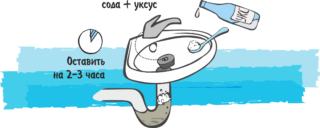 Among folk methods, cleaning with soda powder, sometimes with the addition of salt and vinegar, is most common. Suitable baking soda, calcined and caustic. The latter type also refers to alkaline compounds, but is very caustic. The drug is used if the sewage is metal or polypropylene. PVC pipes cannot be cleaned.
Among folk methods, cleaning with soda powder, sometimes with the addition of salt and vinegar, is most common. Suitable baking soda, calcined and caustic. The latter type also refers to alkaline compounds, but is very caustic. The drug is used if the sewage is metal or polypropylene. PVC pipes cannot be cleaned.
To make a caustic solution, you need to consider the degree of blockage. A mixture of half a glass of soda and three liters of water will dissolve a small cork. A serious problem is resolved by using four kilos of powder per seven liters of water. For preventive purposes, take two kilos of caustic soda in four liters of water.
Cleaning is done in all cases the same. The solution is poured into the drain closest to the blockage, they wait 60 minutes and the pipe is washed well with hot water. After that, you can make the pumping procedures with a plunger so that the dirt is completely exfoliated and rinse the pipe again.
Using regular soda is more affordable and safer. However, sodium bicarbonate is able to remove only light deposits and an unpleasant odor.
- Pour a glass of soda into the drain hole.
- Top with three cups of boiling water.
- Repeat the procedure after 60 minutes.
This method is suitable for the prevention of fat deposits on the inner walls of pipes and unpleasant odors. It can be done once every two weeks.
If the cork is decent, you need to add the following catalysts to the soda powder: vinegar or vinegar essence, diluted with water to nine percent concentration. The reaction of acid and alkali helps to dissolve blockages of various types. You just need to pour half a glass of soda powder into the drain hole, and then pour the same amount of vinegar. The drain is plugged with a rag so that foam does not climb out of it. After a couple of hours, the line is washed with hot water. All procedures are carried out in rubber gloves.
A mixture of soda and salt is also used to clean the pipes. The procedure is easy.At night, mix half a glass of ingredients and pour into a drain hole close to the blockage. Top with a liter of boiling water. Until morning, it is advisable not to use plumbing fixtures.
Home cleaning methods are not expensive, but they will not help with deep blockages with damage to the sewer. However, a medium-sized plug with fatty inclusions is quite capable of dissolving. Also, solutions can be used for prevention, subject to the proportions of caustic components.
Hydrodynamic method
With the help of a hydrodynamic installation, highly clogged lines are cleaned. The essence of the technique is flushing the pipeline under high pressure.
Before working with the device, you must determine the strength of the blockage. To do this, use cables or a technique of television inspection. They will allow you to detect the exact location of the cork.
The cleaning process goes like this:
- In the audit closest to the blockage, the operator lowers a special hose with a piercing nozzle at the end by about a meter.
- With the help of a compression pump, water is supplied to the hose under high pressure (in one and a half hundred atmospheres).
- The nozzle is equipped with holes, from which water flows under pressure. They are wrapped in spirals, thanks to this, the hose is advanced and the plaque is simultaneously cleaned.
The advantage of hydrotreating is that water jets under pressure remove all organic matter and inorganic contaminants. This is not a cheap procedure - from 80 rubles per linear meter, plus the detection of blockage - from 4000 rubles.
If you have a car wash, you can carry out the manipulations yourself, it will be cheaper. You will need to buy a special hose and nozzles, the price of the kit is from 5000 rubles.
Thermal method
The professional version of this technique is similar to the hydrodynamic method. Water flow is supplied under pressure and heated to at least 130 degrees. This makes it possible to dissolve greasy and soapy adhesions. The implementation of this method is complex and expensive, so it is almost never used.
At home, the thermal method is used if the water is bad, but still drains. The hot water tap opens and the pipe is flushed. You can use a regular plumbing hose.
Blockage prevention
To prevent sewage from clogging in an apartment or a private house, regular prevention of blockages is needed. First of all, do not throw garbage or even paper into the toilet. For the used hygiene products, have a special basket.
Other preventive measures for clogging pipes:
- On the drain holes, install special nets that trap hair and organic waste.
- Install grease traps at the bottom of the kitchen sinks, especially if you cook a lot for a large family.
- Once every two weeks, pour 10 liters of an aqueous household solution into plums, or use home-made soda-based techniques.
- Clean siphon devices monthly.
Every six months, it is worth starting preventive cleaning of the pipeline with potent chemicals or a solution of caustic soda.
If a blockage is found, begin to solve the problem in the simplest and most affordable ways. Perhaps the cork will disappear, and you will not have to spend money on professional cleaning.
